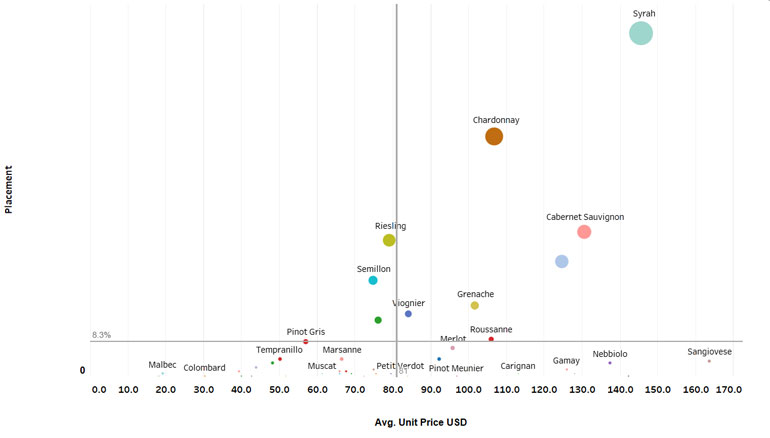Chile: the Southern Hemisphere’s largest wine exporter
Market Bulletin | Issue 57
This week, we look at Chile as a global wine competitor. The amount of wine Chile produces is similar to Australian production, but its international wine sales profile is quite different.
Chile produces around 1.2 billion litres of wine annually, similar to Australia (Australia’s 10-year average is 1.17 billion litres). As well as being at a similar latitude, Chile and Australia are also the only two wine producing countries in the world whose vineyard regions are predominantly phylloxera-free.
Chile has over 200,000 hectares of grapevines, approximately double Australia’s plantings. Its top variety is Cabernet Sauvignon, followed by Chardonnay, Sauvignon Blanc, Merlot and Carmenere – a red variety similar to Merlot that is found almost exclusively in Chile since it was wiped out from France by phylloxera in the 1880s.
The domestic wine market in Chile is relatively small, around 300 million litres, about half that of Australia’s. According to Euromonitor International, wine consumption in Chile peaked in 2004 and was on a downward trajectory from then until 2012. Consumption has gradually increased in the last three years to 13.4 litres per capita per year.
Almost all of the Chilean wine market is supplied by local wine –only 1 per cent is imported, compared with 13 per cent in Australia.
International markets are vital to the Chilean wine producers with three-quarters of wine production exported (compared to 60 per cent for Australia).
Chile is the fourth largest wine exporter in the world after France, Italy and Spain, coming in at around 900 million litres in 2016 despite a very low 2016 harvest. Australia is the next largest and exported 764 million litres in 2016.
Chilean vs Australian wine exports
Despite Chile exporting more in value and volume, Australia is ahead of Chile in value terms in each of the largest export markets for both countries (US, UK, China and Canada)[1]. Australia’s exports also grew more in volume and value than Chile’s in the past 12 months.Chile’s exports to Japan and Germany are more than double Australia’s, but Chile’s exports to Hong Kong – Australia’s fifth largest export market – are miniscule. One reason for this is that Chile ratified free trade agreements with China, Japan and the European Union before Australia did and has benefited from this earlier preferential advantage.
|
|
Chile |
|
Australia |
|
||
|
Market |
Total export value (US$ million) |
Total export volume (million litres) |
Average value (US$/litre) |
Total export value (US$ million) |
Total export volume (million litres) |
Average value (US$/litre) |
|
Overall |
1845 |
907 |
2.03 |
1705 |
764 |
2.23 |
|
US |
246 |
154 |
1.60 |
356 |
165 |
2.16 |
|
UK |
191 |
109 |
1.75 |
266 |
236 |
1.12 |
|
China |
251 |
142 |
1.76 |
385 |
101 |
3.81 |
|
Canada |
96 |
51 |
1.88 |
144 |
61 |
2.36 |
Source: Global Trade Atlas
Chile exports much more wine to Australia than Australia sends to Chile. In 2016, Chile exported 890,000 litres to Australia while Australia sent just 12,000 litres to Chile.
What wines are being exported?
At a variety level, the two countries are quite different. The two charts below show the profile of wines by variety label claim sold in the London on-trade in 2016. The height of the bubble indicates the percentage of establishments selling that wine, the position on the horizontal axis indicates the average unit price in US Dollars (USD) and the size of the bubble indicates the average number of wines per establishment.
Chile’s most popular wines are Cabernet Sauvignon, Sauvignon Blanc (green), Merlot and Carmenere, followed by Chardonnay and Pinot Noir (pale blue).
Figure 1: Chilean wines by variety label claim – London on-trade market

The Australian offering is dominated by Shiraz, followed by Chardonnay and Cabernet Sauvignon. While the average number of Chilean wines is generally larger, the average price for Australian wines of these major varieties is considerably higher.
Figure 2: Australian wines by variety label claim – London on-trade market
 Source: MIBD Market 2016
Source: MIBD Market 2016
For more information contact the Market Insights team at Wine Australia on 8228 2000.
[1] Wine Australia’s published export statistics are slightly different due to variations in method and timing. Global Trade Atlas figures are used here for direct comparison purposes.